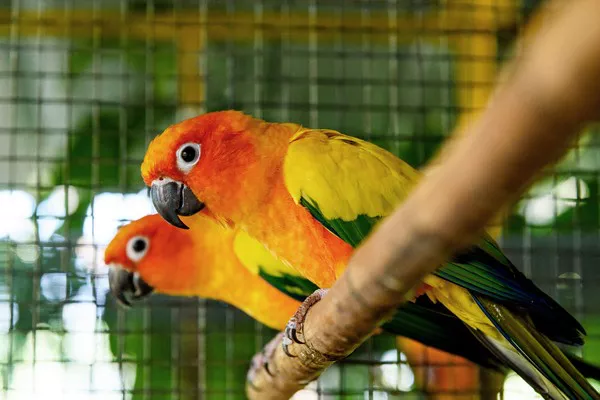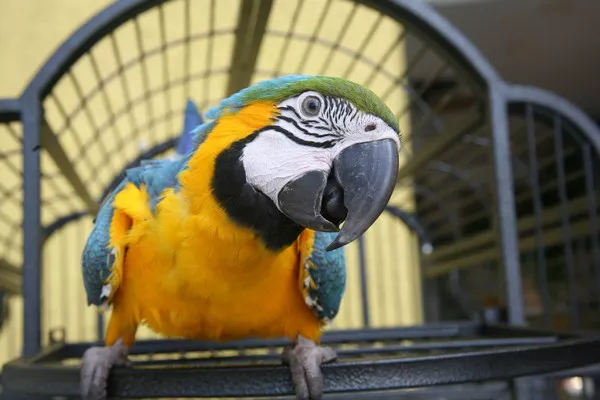Sun conures, known for their vibrant colors and charming personalities, are one of the most beloved species of parrots kept as pets. Their playful nature and strong bond with their owners make them fascinating companions. However, a common question among potential sun conure owners and bird enthusiasts is whether these colorful birds mate for life. In this article, we will explore the mating behaviors of sun conures, their bonding patterns, and the factors that influence their relationships, both in the wild and in captivity.
Sun conures, scientifically known as Aratinga solstitialis, are medium-sized parrots native to the northeastern regions of South America. They are part of the larger conure family, which includes a variety of parrot species known for their intelligence and social nature. Sun conures are particularly well-known for their stunning plumage, which features a bright orange-yellow gradient with green and blue highlights. These birds are highly social, and in the wild, they are often found in flocks that interact in intricate ways. This social behavior extends to their mating habits, where strong pair bonds and social connections play a vital role.
The Mating System of Sun Conures
In the wild, sun conures tend to form strong monogamous bonds, where a male and a female pair up to raise offspring. These bonds are typically established during the breeding season, which occurs during the wet season when food and water are plentiful. Monogamy, or the practice of forming a lifelong pair bond, is common in many parrot species, and sun conures are no exception.
The formation of these bonds begins when a male sun conure courtships a female. During courtship, the male engages in various behaviors to attract the female’s attention. These may include vocalizations, showing off his bright plumage, and feeding the female. Once the female is impressed, she will accept the male as a mate. After this initial courtship phase, the couple will continue to stay together and raise multiple clutches of eggs throughout their mating season.
In the wild, sun conures mate for life, meaning once they have established a bond, they tend to stay with the same mate year after year. The pair will often return to the same nesting sites, ensuring their bond remains strong over time. This long-term commitment provides the birds with stability, allowing them to successfully raise their offspring together.
Do Sun Conures Mate for Life in Captivity?
While sun conures exhibit monogamous behaviors in the wild, the question remains whether they maintain these lifelong pair bonds when kept in captivity. The answer is generally yes, but with certain nuances. In captivity, where environmental factors are controlled, sun conures can form lasting bonds with their mates, much like they do in the wild.
However, the dynamics of their relationships may differ slightly due to their living conditions. In captivity, sun conures are often housed in pairs, and many owners may even attempt to pair up birds intentionally. In some cases, birds may not immediately bond with one another or may take some time to adjust. This is not a sign that sun conures are incapable of forming lifelong bonds, but rather a reflection of the birds’ need for time and space to develop trust.
Additionally, captive sun conures often have more human interaction than their wild counterparts. While they still develop strong pair bonds with their mates, the presence of a human owner can also influence the bird’s behavior. Some sun conures may form a strong attachment to their human caregiver, sometimes even to the point of being less interested in bonding with other birds. In these cases, the bird may form a lifelong attachment to the human rather than another sun conure.
Why Do Sun Conures Mate for Life?
The tendency for sun conures to mate for life can be attributed to a variety of factors, including the biology of the species, evolutionary advantages, and the birds’ social nature. Let’s explore some of the key reasons behind their long-term pair bonds.
Biological and Evolutionary Factors: One of the main reasons why sun conures form lifelong bonds is tied to the survival of their species. In the wild, raising offspring requires both parents to contribute. The female lays the eggs, and both the male and female take turns incubating the eggs and feeding the young once they hatch. A stable, long-term bond between the two parents ensures that the chicks are cared for adequately, increasing their chances of survival.
From an evolutionary standpoint, the formation of lifelong pair bonds helps ensure the continuation of the species. Sun conures that mate for life are more likely to produce healthy offspring who grow up with strong socialization and support from both parents. In the wild, these bonds provide the pair with a higher success rate in raising their young and protecting them from predators.
Social Nature of Sun Conures: Sun conures are incredibly social birds. They are highly intelligent and thrive in environments where they can interact with others. The bond between a male and a female sun conure is not only based on reproduction but also on companionship. Sun conures spend a lot of time together, grooming, communicating, and interacting. These social behaviors strengthen the bond between the two birds, making it more likely that they will stay together for life.
Sun conures also display behaviors such as mutual preening and vocalizations that help reinforce their pair bond. The physical closeness and constant communication between mates create a deep connection that is maintained throughout their lives.
Environmental Stability: In the wild, sun conures form long-lasting relationships because of the environmental stability provided by the breeding season. During this time, food and water are more abundant, and there is less competition for resources. The pair can focus on raising their offspring and maintaining their bond. In captivity, while the environment is controlled, sun conures may continue to mate for life due to the stability provided by their living conditions. The availability of food, a safe space for nesting, and a consistent routine can help foster strong pair bonds that last throughout their lives.
Can Sun Conures Break Up?
Although sun conures generally mate for life, there are situations where a pair may break up or become separated. These cases are relatively rare, but they can occur due to factors such as:
Health Issues: If one of the pair members becomes sick or injured, the bond may weaken. In extreme cases, one of the birds may die, leaving the surviving bird without a mate. In captivity, the surviving bird may be introduced to a new mate, although it may take time for the new pair to bond.
Environmental Stress: Factors like noise, changes in habitat, or the introduction of a new bird into the environment can cause stress, which may lead to tension between mates. This stress may disrupt the bond temporarily, but with proper management, the pair may continue to stay together.
Human Intervention: In some cases, human interference, such as separating a pair for breeding purposes or due to a move to a new home, can disrupt the bond between sun conures. However, with patience and time, it is often possible to restore the relationship between the birds.
While sun conures are known for their strong pair bonds, these birds are also adaptable and resilient. Even if a break occurs, they may eventually form new bonds with other conures or even human caregivers, depending on the circumstances.
Signs That Sun Conures Are in Love
Observing a sun conure and its mate can reveal a lot about the strength of their bond. There are several behaviors that indicate a deep connection between two sun conures:
Preening: Sun conures engage in mutual preening, which is a sign of affection and trust. They will often groom each other’s feathers, focusing on areas that are difficult to reach, such as the head and neck.
Vocalizations: Sun conures communicate with a variety of vocalizations, including chirps, squawks, and whistles. Mated pairs often develop specific vocal patterns that are unique to them, which is a form of bonding.
Feeding: One of the most endearing behaviors of sun conures is the act of feeding each other. A male sun conure may regurgitate food for the female as a sign of courtship and affection. This behavior continues even after the pair is established as a mated couple.
Shared Sleeping Spaces: Sun conures often sleep close to each other, which helps strengthen their bond. They may snuggle together on the same perch or nest, demonstrating their comfort and closeness.
Protectiveness: A mated pair of sun conures will often protect each other from perceived threats. The male may become particularly defensive if the female is threatened or feels unsafe, showcasing his dedication to the relationship.
Conclusion
Sun conures are known for their strong, lifelong pair bonds in the wild, and these bonds continue to manifest in captivity. Their social nature, intelligence, and need for companionship make them natural candidates for forming lasting relationships. Whether in the wild or in captivity, sun conures tend to mate for life, staying loyal to their partners through thick and thin. However, like all creatures, their bonds can be affected by health, environmental stress, or human intervention.
Understanding the mating behavior of sun conures and the factors that influence their relationships can help owners provide the best care for their birds. By recognizing the signs of affection and supporting their need for companionship, we can ensure that sun conures thrive in their homes and maintain the strong bonds they are known for.
Related Topics:























